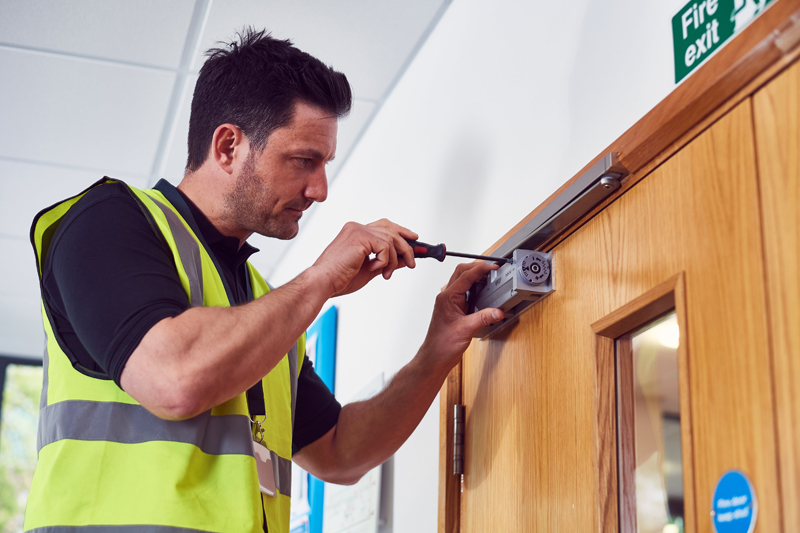 As educational facilities revel in a summertime of empty hallways and classrooms, Sue Corrick of Allegion UK explains why it’s the perfect time to assess fire door hardware.
As educational facilities revel in a summertime of empty hallways and classrooms, Sue Corrick of Allegion UK explains why it’s the perfect time to assess fire door hardware.
The great British summertime has arrived, known for its quintessential rainy days, packed out beach fronts and extended educational term breaks. By the time we reach August, students of all ages – from primary schools to universities – have dashed out the doors in preparation for a summer of fun, leaving behind empty academic facilities in the process.
For most of the 32,163 schools, 277 colleges and 164 universities in the UK, the extended summer break is seen as a time to reset. Yet, it also provides decision makers with a prime period to assess and attend to their facilities ahead of the new term. Educational spaces are often prone to wear and damage, as a result of their high footfall (and naturally well-trodden environments). Door hardware for example, plays an integral role in the security, traversal and fire safety of academic settings and can be operated 100’s to 1000’s of times each day, becoming tired in the process. As such, when door hardware is left to deteriorate it can lead to inadequate operation and thus compromise fire safety and security.
During term time, a fire incident can affect the operation of an educational setting, disrupting student learning and disturbing staff morale – not to mention the economic strain as a result of building damage. Over periods of closure, this vulnerability can become even more alarming – particularly for unoccupied school buildings where many fires are started deliberately and arson is a common offence, accounting for up 70% of fire safety incidents for some local authority fire brigades. And with the UK Fire Service called out to extinguish fires in approximately 1,500 UK schools per year, the necessity of maintenance periods is more evident than ever. Fortunately, making positive change over the summer break can make an instant impact, but where does the responsibility lie?
Head of fire safety
As is stated under the Regulatory Reform (Fire Safety) Order 2005, all educational establishments must designate a Responsible Person (RP) for matters associated with fire safety. In some cases, responsibility can be shared between a single person and the local authority or building owner, but as part of their obligations, the RP must possess a robust knowledge of fire safety and manage ongoing risk assessments, designed to help identify potential fire hazards within the premises. As part of their responsibilities, the designated RP must:
- Ensure necessary persons are trained on fire safety
- Conduct fire safety inspections, ensuring escape routes are clear and fire door sets are operating effectively
- Ensure firefighting equipment meets regulations
- Check to ensure fire alarms and smoke detectors work correctly and effectively
In the event of a fire, should an educational establishment be considered unsafe or breach the Regulatory Reform (Fire Safety) Order 2005, it is in danger of heavy penalties, fines and a damaged reputation.
Alarmingly, the latest research from the BWF Alliance has revealed that almost a third of those responsible for fire doors do not understand fire door responsibility under the Building Safety Act 2022. Passed in April, the new Building Safety Bill is designed to raise fire safety standards in multi-occupancy buildings, by giving residents more power to hold responsible persons to account. The change is applicable for those residing in halls of accommodation at universities and comes to further combat a rise in incidents, of which in the past year, London firefighters attended 1,262 incidents at student halls in the capital alone. Under new guidance the RP is required to present residents with annual information covering the importance of fire doors and self-closing devices. Furthermore, residents are encouraged to raise any faults or damage to door sets immediately, helping to ensure maintenance is addressed quickly and professionally.
 Ready for open doors
Ready for open doors
Equipped with newly released budgets, reduced building footfall and blessed with time, the summer break presents responsible persons with an opportunistic six-week period to review fire safety and assess the operation of fire doors and their hardware. And while no academic facility is the same, all are legally bound under British and European law to possess operational fire door sets, which consist of:
- Door furniture
- Hinges
- Locks and latches
- Door closers
- Signage
- Exit devices
Above all else, fire doors must operate as intended. In the circumstance of a fire, it’s critical that fire doors close independently and all the way, and that hardware – including hinges, handles, door closers, locks and signage – is correctly installed and maintained. And so, when it comes to inspections, it is common practice to follow a stringent five-point check, where upon examination, a responsible person must review the certification, gaps, seals, hinges and the closing elements of a fire door, ensuring each element is functioning correctly.
Fires are extremely unpredictable and can begin in and out of learning hours. And when you consider that something as rudimental as an incorrect hinge can produce a life-threatening gap between the door and its frame, the need for regular maintenance periods is clear. The fleeting British summertime leaves a small – but manageable – window for the education sector to act, adding fire safety to their own curriculum before students return and begin their own courses in September.


